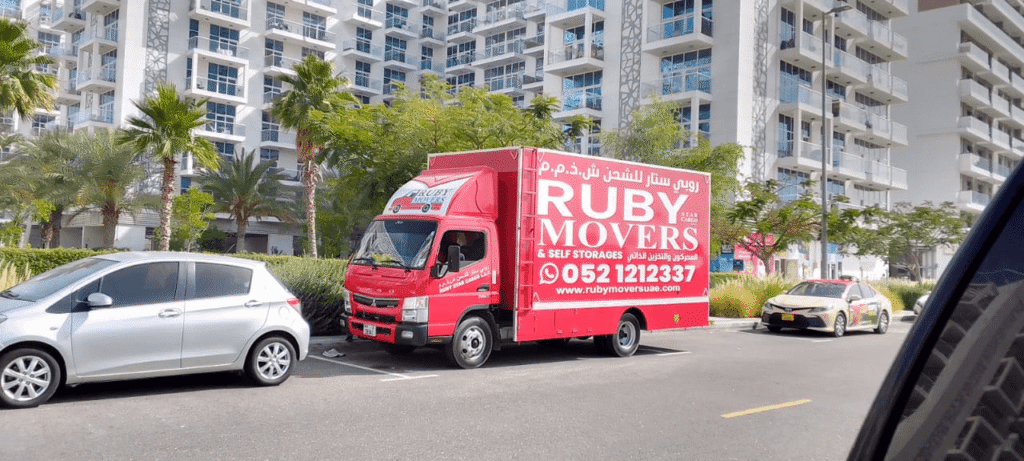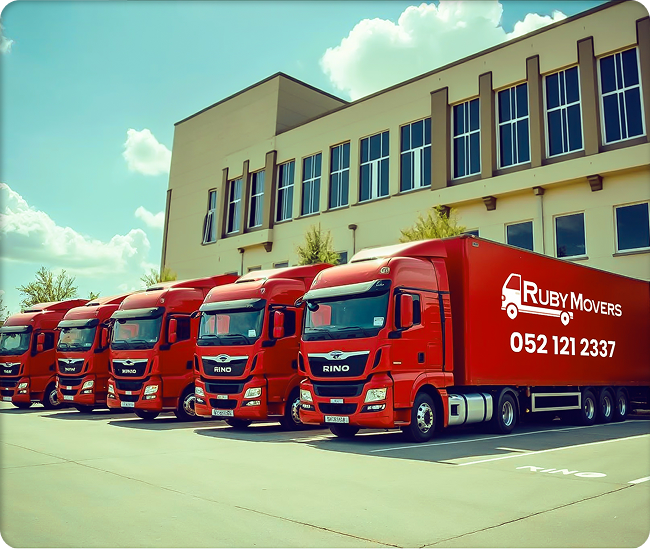Moving into or out of Downtown Dubai is not as simple as hiring a truck and loading boxes. Residents and moving companies face strict concierge policies, mandatory service elevator bookings, and highly regulated dock etiquette that can either make or break moving day.
Why does this matter? With limited elevators, high pedestrian activity, and narrow service docks, even a single unscheduled move can disrupt building safety and traffic flow.
This guide reveals the secret rules movers in Downtown Dubai must follow. You’ll learn:
- Why concierge approvals are mandatory and how to secure them
- How to book service elevators and avoid costly mistakes
- The dos and don’ts of loading bay and dock etiquette
- What happens if movers break the rules
- A step-by-step checklist to prepare for a smooth moving day
By the end, you’ll know exactly how to navigate these hidden procedures, avoid penalties, and ensure your move in Downtown Dubai is seamless, efficient, and stress-free.

What Are the Concierge Policies for Movers in Downtown Dubai?
Moving in Downtown Dubai always begins with concierge approval. Without it, trucks are denied entry and moves are rescheduled at extra cost. Permits are designed to keep service elevators, docks, and common areas running smoothly.
What Are the Concierge Policies for Movers in Downtown Dubai?
Core rule: Moving in Downtown Dubai starts with a concierge-issued Move-In/Move-Out Permit (NOC); security can deny access to trucks if a valid permit is not on file. This is explicit in Emaar Community Management guidance and is widely mirrored across premium towers.
Why permits exist (operational + safety basis)
Permits coordinate service-elevator traffic, protect loading docks/common areas, and align with UAE safety regimes that require periodic (biannual) elevator inspections by accredited bodies. One reason is that buildings tightly manage heavy moves.
Required documents (typical Downtown set)
To ensure compliance, most Downtown Dubai buildings require a consistent set of documents. These records verify your right to occupy, confirm mover licensing, and align move scheduling with building operations:
- Proof of right to occupy: Tenancy contract/Ejari for tenants or title deed for owners.
- Identity: Emirates ID or passport + visa copy.
- Mover credentials: Licensed company name and truck details (plate number/size).
- Move specifics: Date, time window, tower, and unit to sync with lift/dock schedules.
Processing times & practical lead time
Approvals are fast when documents are correct, but peak season delays are common.
- Typical issuance: ~1–2 business days when files are correct.
- Peak-period buffer: Apply 5–7 days ahead (market guidance) to avoid month-end backlog.
- Actionable best practice: Submit ≥3 working days before move, confirm with concierge, and keep the approval email/screenshot ready for gate staff.
Move hours & restrictions you should plan around
Concierge permits aren’t open-ended; moves must be timed to minimize resident disruption.
- Dubai Properties communities: Moves are commonly limited to 08:00–19:00, Saturday–Thursday; Downtown towers often mirror these daytime windows to reduce disruption.
- Some buildings restrict weekends, pushing moves to weekdays to protect resident experience and lift availability.
Enforcement examples (developer portals & access rules)
- Emaar: Access will be denied without a Move-In Permit.
- Nakheel: Move permits must be filed via My Nakheel portal before relocation.
Penalties to factor into planning (outside building fines)
- AED 1,000 for loading/unloading outside designated areas and AED 1,000 for stopping in the middle of the road without a justified reason, fines that can apply to moving trucks if bays aren’t used correctly.
- Separate from traffic law, tampering with or obstructing building fire-safety systems (e.g., blocking hydrants/exits during a move) draws penalties between AED 20,000 and AED 250,000 per Civil Defence notices.
One-minute checklist (concierge stage)
- Apply on the right portal: (Emaar One/ECM, RealConnect for Dubai Properties, My Nakheel), attaching Ejari/ID and mover + truck details.
- Time it: Target ≥3 working days pre-move; expect ~1–2 business days approval when complete.
- Align slots: Request a daytime window (08:00–19:00 Sat–Thu) and keep the approval screenshot ready for security.
How Do Service Elevator Bookings Work in Downtown Dubai?
Movers in Downtown Dubai must pre-book a dedicated service elevator slot (commonly 1–3 hours) through the concierge or community portal, or risk delays, refusal, or fines for misuse/damage.
Elevator reservations prevent resident congestion and protect lift interiors. Buildings treat freight/service lifts as critical assets; overloading or using passenger lifts for bulk items is typically prohibited. Book early and pad time around peak dates.

Booking the Lift: the Core Workflow
- Movers must submit a booking request either via the building’s resident portal or directly to the concierge team.
- Common slot durations are 1 to 3 hours, timed with the moving truck’s arrival.
- In many cases, the elevator “clock” begins the moment the truck arrives, even before the first item is loaded.
This approach aligns traffic flow within the tower, minimizes waiting, and avoids overlap with resident or maintenance usage.
Risks, Restrictions & Compliance Rules
- Only freight/service lifts are allowed for bulky moves; passenger lifts are off-limits for large items or furniture.
- Overloading the lift or scratching walls/floors triggers damage charges billed to residents or movers.
- Persistent violations or heavy abuse can threaten the building’s occupancy permit under local codes.
Elevator Safety Regulations in Dubai demand strict compliance. Buildings are required to maintain regular inspections and safety standards to protect infrastructure and residents.
Safety, Maintenance & Inspection Mandates
- In the UAE, all elevators must undergo biannual safety inspections by accredited bodies to verify mechanical integrity, safety systems, and load performance.
- The Dubai Building Code (2021) outlines minimum safety objectives and protocols for lifts, mandating that buildings control and manage vertical transport in accordance with those standards.
- Certified inspection firms such as ITAC Safety advertise that they inspect lifts in Dubai at least every six months as part of compliance services.
These regulations underpin why building management enforces elevator booking discipline, and why damage or misuse is not tolerated.
Best Practices to Secure Smooth Elevator Use
- Book at least 48 hours before your move, and more ahead during peak months.
- Request that the concierge unlock and pad the lift with protective covers before loading.
- Use floor runners, corner guards, and document lift condition before and after your move with clear photos or video.
These practical steps mitigate risk disputes. Buildings expect residents and movers to follow them.
Typical Service Elevator Booking Parameters in Downtown Dubai Towers
| Tower/Developer (Example) | Standard Slot Duration | Typical Lift Dimensions* | Booking Lead Time | Notes & Penalties |
|---|---|---|---|---|
| Emaar Towers (Downtown Burj area) | 2–3 hours per move | Height ~2.3m, Width ~1.5m, Depth ~1.6m | Apply 3–4 working days prior | No entry without permit; trucks turned away at gate (Emaar Community Management, 2023). |
| Dubai Properties Communities | 2 hours standard | Freight lifts sized for wardrobes/appliances (varies by tower) | Permit approval in ~2 business days | Moves allowed 08:00–19:00, Sat–Thu; damage to lift = fines (Dubai Properties, 2023). |
| Nakheel High-Rises (Palm, JLT, etc.) | 1–2 hours | Heavy-duty service lifts reinforced with padding | Apply 3–5 days in advance | Reservation via My Nakheel portal; overstay fines apply (Nakheel, 2023). |
| Boulevard & Address Residences (Downtown Dubai) | 2–3 hours | Larger service lifts (~1.5–2 tons capacity) | Apply ≥5 days in advance for weekends | Overloading or using passenger lifts leads to fines; the concierge can halt the move (local mover guidance, 2023). |
What Are the Docking & Loading Bay Etiquette Rules in Downtown Dubai?
In Downtown Dubai’s podium roads and service corridors, loading bays run on the same discipline as service elevators. Booked windows, pre-registered trucks, and clear fire routes keep high-rise operations safe. Skipping these rules triggers traffic penalties under federal law, plus building charges.
Designated Loading Zones & Hours
Loading must happen inside the building’s assigned bay and within an approved time window that usually aligns with service-lift slots. The goal is simple: no curbside crowding, no blocked ramps, no unscheduled idling.
- Downtown towers commonly specify loading bays in the move-in/out permit and restrict hours to daytime windows; Dubai Properties guidance cites 08:00–19:00, Saturday–Thursday, as a standard moving period.
- Using non-designated areas risks municipal enforcement in addition to building penalties. Federal traffic rules fine AED 1,000 for loading/unloading outside designated areas.
Vehicle Registration & Access Limits
Security needs to know which truck, how big, and when. Podium heights, turning radii, and shared ramps are tight; oversized or unregistered vehicles create bottlenecks.
- Permit portals for DP communities collect truck plate numbers and vehicle details as part of the move request.
- Expect limits for heavy or over-height trucks in podium zones; management may require alternate routing or off-peak docking to keep traffic flowing.

Fines & Enforcement That Affect Movers
Curbside violations sit under the UAE federal traffic law; building rules come on top of that. Treat the bay as your only legal place to stage.
- Loading/unloading outside designated areas: AED 1,000 + 4 black points.
- Stopping in the middle of the road without a justified reason: AED 1,000 + 6 black points.
- Parking in front of fire-hydrant places: AED 1,000 + 6 black points.
- Tampering with or disabling building fire-safety systems (e.g., covering sprinklers during a move): AED 10,000 fine per Abu Dhabi Civil Defence notice referencing Cabinet Resolution No. 24/2012; similar enforcement is communicated across the UAE.
Loading Etiquette & Damage Control
The dock is a shared asset. Management expects protection, speed, and zero trace once you leave.
- Use runner mats, corner guards, and padded blankets; don’t drag large pieces across floors or walls.
- Photograph the dock and route (before/after). Many towers perform a post-move inspection prior to releasing deposits. (Practice aligns with building handbooks and service-lift rules.)
- Clear all tape, cartons, and debris immediately after unloading to prevent slip hazards and complaints.
Best-Practice Timeline (Dock + Curb)
Sync the dock with the elevator. You’ll avoid idle time and the fines that come with “just five minutes” at the curb.
- Before approval: Submit truck plate, length/height, and expected arrival window with your permit.
- 24–48 hours out: Reconfirm the assigned bay and lift slot; share the bay map and route with your driver.
- Move day: Arrive 15 minutes early, stage inside the bay only, and keep fire exits/hydrants clear at all times.
Curbside Rules & Penalties
| Situation at the podium/curb | What the rule says | Statutory penalty |
|---|---|---|
| Loading/unloading outside the designated bay | Must load in designated areas only | AED 1,000 + 4 black points |
| Stopping in the middle of the road “just to unload” | Unjustified road stopping is prohibited | AED 1,000 + 6 black points |
| Parking in front of fire hydrants | Hydrant zones must stay clear | AED 1,000 + 6 black points |
| Disabling/covering fire-safety systems during a move | Tampering with suppression/alarm systems is prohibited | AED 10,000 (Civil Defence) |
Why Downtown Buildings Insist on Dock Discipline
These aren’t “nice-to-haves.” They protect vertical transport and life-safety systems while keeping podium traffic moving.
- Community guidance ties moving activity to 08:00–19:00 (Sat–Thu) to limit impact on residents and services.
- Federal traffic schedules quantify curbside risks with specific AED penalties and black-point values, which is why security insists on using the assigned bay.
- AED 10,000 fines for interfering with suppression systems, reason docks and routes stay clear.

What Happens If Movers Don’t Follow These Rules?
In Downtown Dubai, move-day is governed by hard controls: concierge permits, booked service elevators, and designated loading bays. Break any one of them, and the cascade is fast security refusal, forced rescheduling, and traffic or safety fines on top of building charges. Treat the rules as operational guardrails, not suggestions.
Why are the consequences strict?
Premium towers coordinate vertical transport and life-safety systems under the Dubai Building Code (2021) and periodic lift inspections. That’s why entry is tied to permits, lifts are rationed in slots, and docks must stay clear.
Access denial & rescheduling (permit missing or wrong)
No valid move-in/move-out permit (NOC) = no entry. Emaar Community Management states access is denied without an approved move-in permit; trucks are turned away until the permit is visible to security. That usually means same-day delays or a new date.
Traffic & curbside penalties (wrong bay, blocking lanes)
- UAE’s federal schedule sets explicit fines that hit moving trucks when bays aren’t used correctly:
- Loading/unloading outside designated areas: AED 1,000 + 4 black points.
- Stopping in the middle of the road without a justified reason: AED 1,000 + 6 black points.
- Parking in front of fire-hydrant places: AED 1,000 + 6 black points.
These penalties apply in addition to any internal building charges for misuse of docks or overstay. Keep all curbside activity inside the assigned loading bay and time window.
Fire-safety violations (blocked exits, tampered systems)
Tampering with, covering, or disconnecting fire-suppression components (e.g., sprinklers near the dock route) draws an AED 10,000 fine under Civil Defence enforcement. Blocking fire routes risks the same scrutiny.
Elevator misuse & regulatory exposure (unbooked or overloaded moves)
Using passenger lifts for bulk items, overloading the service car, or moving without a booked slot can lead to building penalties and liability for any damage.
The backdrop: UAE practice requires biannual elevator inspections by accredited bodies; building managers, therefore, enforce strict elevator controls to stay compliant with the Dubai Building Code.
Building-level charges & reputational impact
Management typically bills actual repair costs for scuffed walls, damaged doors, or scratched elevator interiors; some towers add overstay charges if you exceed the slot. Repeat incidents can get a mover flagged for stricter screening or bigger deposits on future bookings. (Exact amounts vary by building; check your house rules.)
Non-Compliance Risk Matrix
| Scenario | Typical trigger | What happens | Impact |
|---|---|---|---|
| No permit at the gate | NOC not in system / wrong unit details | Access denied; move deferred | Lost crew time, extra truck hours |
| No elevator booking | Turn up without a service-lift slot | Refusal or long wait; possible reschedule | Missed slot, extra fees, upset residents |
| Wrong bay / curbside loading | Unload at curb, block ramps | Traffic fine AED 1,000 (+ black points) | Monetary penalty + building warning |
| Hydrant/exits obstructed | Park or stage across the hydrant/egress | AED 1,000 hydrant fine; safety violation | Penalty + possible tow |
| Fire-system tampering | Cover sprinklers, disable alarms | AED 10,000 Civil Defence fine | High penalty; potential legal action |
| Lift damage/overload | Scratches, dents, and door misalignment | Repair billed to tenant/mover; penalties | Direct cost + reputational hit |
Bottom line for movers in Downtown Dubai
- Permit first, or expect refusal: Emaar confirms no permit, no access.
- Elevator rules exist for safety: Lifts are governed by the Dubai Building Code and checked every six months by accredited inspectors; misuse increases liability.
- Docks aren’t optional: UAE law prices curbside mistakes at AED 1,000 per violation (e.g., loading outside designated areas, blocking a lane, or using a hydrant).
- Fire routes are a red line: Tampering/obstruction can cost AED 10,000.

How Can Residents Prepare for a Smooth Moving Day in Downtown Dubai?
Plan ahead, obtain permits, book elevator/dock slots, supply completed documentation to movers, stage protection, and monitor execution carefully.
Checklist & Best Practices
| Step | Action | Why It Matters | Suggested Timeline |
|---|---|---|---|
| 1 | Submit move permit / NOC request | Ensures concierge authorization | 3–5 business days before the move |
| 2 | Reserve service elevator slot | Avoid scheduling conflicts | Alongside permit submission |
| 3 | Share mover credentials & truck details | For security and verification | 1–2 days before move |
| 4 | Confirm truck registration, size, and access path | To ensure loading bay compatibility | 1–2 days prior |
| 5 | Provide movers with a copy of the move permit copy | For on-site checks with security | On move day |
| 6 | Lay down floor runners, padding | Protect floors/walls | Just before moving items |
| 7 | Stage close to the loading bay | Reduce haul distance & time | Move day starts |
| 8 | Monitor timing carefully | Avoid surcharges or overruns | Throughout the move |
| 9 | Photograph common areas pre/post | Document condition | Before unloading and after finishing |
| 10 | Communicate with concierge/security | Coordinate flow & avoid conflict | Start and end of move |
Mover insights: Industry surveys suggest that 70% of delays on moving day come from missing permits or elevator booking errors. Being prepared prevents both delays and financial penalties.
Conclusion: Compliance Is the Shortcut to a Smooth Downtown Dubai Move
A successful move in Downtown Dubai isn’t about luck; it’s about procedure. When residents and movers secure a concierge Move-In/Move-Out permit (NOC), pre-book a service elevator for a defined 1–3 hour slot, and load strictly inside the designated bay during daytime windows (commonly 08:00–19:00, Sat–Thu), move day runs on rails.
The payoffs are immediate: no gate refusals, no reschedules, fewer disputes, and protection from avoidable penalties like AED 1,000 curbside fines or AED 10,000 fire-safety violations. Treat the rules as your project plans. Submit documents 3–5 working days ahead, align the dock with the lift booking, protect common areas, and photo-document before/after. That’s how movers in Downtown Dubai achieve a clean handover, on time and on budget.
FAQs
Do I really need a concierge permit (NOC) to move in Downtown Dubai?
Yes. Buildings can deny truck access without a valid NOC in the system. The permit synchronizes security clearance, service-lift allocation, and dock timing, preventing bottlenecks and damage claims.
How far in advance should I apply for the NOC?
Apply 3–5 working days before moving; typical approvals land in ~1–2 business days when documents are correct. For month-end peaks, buffer 5–7 days.
Which documents are usually required?
Ejari/tenancy or title deed, Emirates ID or passport + visa, licensed mover details + truck plate/size, and scheduled date/time with tower and unit. Submit clear scans and ensure names/units match Ejari.
What are the standard moving hours in the Downtown Dubai towers?
Daytime windows are often 19:00, Saturday–Thursday. Many towers restrict weekend moves to limit noise and congestion.
How do service elevator bookings work?
You (or your mover) pre-book a dedicated service/freight lift via the portal/concierge for 1–3 hours. The “clock” often starts when the truck arrives. Passenger lifts are not permitted for bulky items.
What happens if we overload or damage the elevator?
Expect repair charges billed to the resident/mover and possible penalties under building rules. Lifts are inspected every six months, so management enforces strict protection (padding, corner guards) and capacity limits.
Where can the truck load/unload?
Inside the assigned loading bay only. Curbside shortcuts risk AED 1,000 fines for loading outside designated areas, AED 1,000 for stopping mid-road, and AED 1,000 for blocking hydrants, separate from any building-level fees.
Are there fire-safety red lines during moves?
Yes. Do not block fire exits or hydrants, and never cover or tamper with suppression/alarm equipment. Violations can draw AED 10,000 penalties.
What are the top reasons moves get delayed or refused?
Three patterns cause most disruption:
(a) No NOC at the gate
(b) No service-lift booking or missed slot
(c) Wrong bay or curbside unloading
Internally, movers report ~70% of delays are linked to missing approvals or poor scheduling.
What’s the best “zero-penalty” checklist for move day?
Permit ready (digital/printed), names/units match
Service lift booked (padded, unlocked at start time)
Bay reserved (truck plate/size pre-cleared)
Protection in place (runners, corner guards, blankets)
Photo log of elevator/corridors before & after
Timing discipline (arrive 15 min early, finish within slot)





